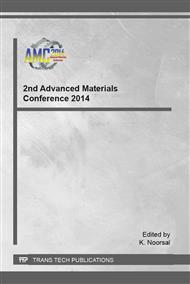[1]
Information on http: /ilo. osu. edu/2010/09/14/bio-friendly-fillers-for-polymers.
Google Scholar
[2]
J.K. Pandey, A.N. Nakagaito, H. Takagi, Fabrication and applications of cellulose nano-particle based polymer composites, Polymer Eng. & Sci. 53 (2013) 1-8.
DOI: 10.1002/pen.23242
Google Scholar
[3]
S.M. Jang, M.C. Li, J.H. Lim, U.R. Cho, Study on properties of natural rubber compound using starch as filler, Asian J. Chem. 25 (9) (2013) 5221-5225.
DOI: 10.14233/ajchem.2013.f22
Google Scholar
[4]
S. Poompradub, Y. Ikeda, Y. Kokubo, T. Shiono, Cuttlebone as reinforcing filler for natural rubber, J. European Polymer. 44 (2008) 4157-4164.
DOI: 10.1016/j.eurpolymj.2008.09.015
Google Scholar
[5]
M. Komethy, I. Hanafi, O. Nadras, Biodegradation, morphology and FTIR study of rattan powder filled natural rubber composites as function of a filler loading and a silane coupling agent, Bioresources. 7 (1) (2012) 957-971.
DOI: 10.15376/biores.7.1.957-971
Google Scholar
[6]
M. El-Sakhawy, M.L. Hassan, Physical and mechanical properties of microcrystalline cellulose prepared from agricultural residue, Carbohydrate Polymers. 67 (2007) 1-10.
DOI: 10.1016/j.carbpol.2006.04.009
Google Scholar
[7]
M.K.M. Haafiz, S.J. Eichhorn, H. Azman, M. Jawaid, Isolation and characterisation of microcrystalline cellulose from oil palm biomass residue, Carbohydrate Polymers. 93 (2013) 628-634.
DOI: 10.1016/j.carbpol.2013.01.035
Google Scholar
[8]
M.J. John, R.D. Anandjiwala, Recent development in chemical modification and characterisation of natural fibre reinforced composite, Polymer Composite. 29 (2) (2008) 187-207.
Google Scholar
[9]
X. Li, L.G. Tabil, S. Panigrashi, Chemicals treatments of natural fiber for use in natural fibre-reinforced composite: A review, J. Polymer Environment. 15 (2007) 25-33.
Google Scholar
[10]
M. Rom, J. Dutkiewicz, B. Fryczkowka, R. Fryczkowka, The hydrophobisation of cellulose pulp, Fibres and Textiles in Eastern Europe. 15 (5-6) (2007) 64-65.
Google Scholar
[11]
H.H. Le, E. Hamman, S. Ilisch, G. Heinrich, H.J. Radusch, Selective wetting and dispersion of filler in rubber composites under influence of processing and curing additives, Polymer. 55 (2014) 1560-1569.
DOI: 10.1016/j.polymer.2014.02.002
Google Scholar
[12]
A.E. Nesterov, Y.S. Lipatov, Compatibilizing effect of filler in binary polymer mixtures, Polymer. 40 (1999) 1347-1349.
DOI: 10.1016/s0032-3861(98)00277-8
Google Scholar
[13]
B.A. Dogadkin, L.G. Senatorskya, V.I. Guseva, A.V. Suslyakov, P.I. Zakharchenko, Filler-rubber interaction in latex, Rub. Chem. Technol. 31 (1958) 655-663.
DOI: 10.5254/1.3542322
Google Scholar
[14]
P. Strunk, B. Eliasson, C. Hägglund, Agnemo, The influence of properties in cellulose pulp on the reactivity in viscose manufacturing, J. Nordic Pulp and Paper Research. 26 (1) 81-89.
DOI: 10.3183/npprj-2011-26-01-p081-089
Google Scholar
[15]
V. Kanjanarnun, T. Prodpran, S. Prasarpran, Effect of epoxidized natural rubber (enr) on film and adhesive properties of Polyvinyl alcohol (PVA), International Journal of Science Research. 3 (1) (2014) 134-137.
DOI: 10.15373/22778179/jan2014/44
Google Scholar
[16]
N.M. Claramma, L. Varghese, N.M. Mathew, Effect of filler on the properties of prevulcanized natural rubber latex film, J. Elastomers and Plastics. 31 (1999) 130-142.
DOI: 10.1177/009524439903100203
Google Scholar
[17]
M. Bijarimi, A. Sahrim, R. Rozaidi, Melt blends of poly (lactic acid) / natural rubber and liquid epoxidised natural rubber, J. Rubb. Res. 17 (2) (2014) 57-68.
Google Scholar


